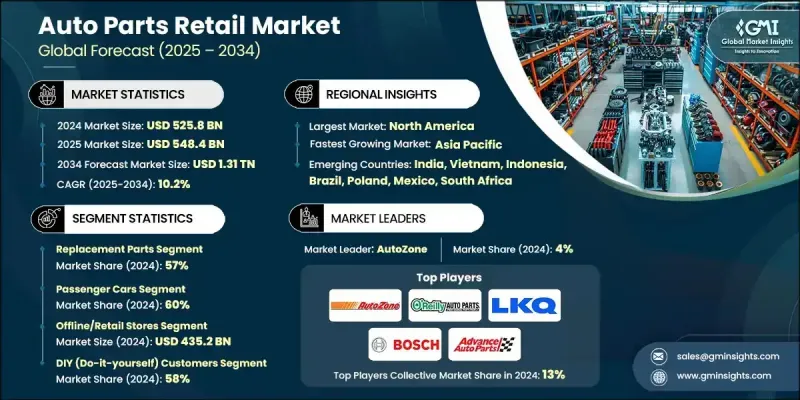
|
시장보고서
상품코드
1844257
자동차 부품 소매 시장 : 시장 기회, 성장 촉진요인, 산업 동향 분석, 예측(2025-2034년)Auto Parts Retail Market Opportunity, Growth Drivers, Industry Trend Analysis, and Forecast 2025 - 2034 |
||||||
세계의 자동차 부품 소매 시장 규모는 2024년에 5,258억 달러로 평가되었고, CAGR 10.2%로 성장할 전망이며, 2034년에는 1조 3,100억 달러에 달할 것으로 예측되고 있습니다.

이 시장은 디지털 혁신과 고객 행동의 진화에 힘입어 큰 변혁기를 맞이하고 있습니다. 전자상거래에서는 소매업체가 AI 툴을 통합하여 맞춤형 상품 제안을 하고, 구독형 모델을 제공하며, 클릭 앤 콜렉트 시스템을 개발하고, 부품의 구입 및 배송 방법을 재구축하고 있습니다. 예측 재고 관리와 라스트 원마일 물류는 표준이 되고 있습니다. 지속가능성에 관한 규제도 애프터마켓을 재구축하고 있으며, 재생 부품에 대한 수요가 높아지고 OEM, 재활용업체, 유통업체 간의 협력 체제가 강화되고 있습니다. 서큘러 이코노미 연습은 현재 제품 설계, 조달 및 포장에 영향을 미치고 있습니다. 또한 커넥티드 차량 기술은 실시간 진단 및 유지보수 경보를 가능하게 하며 사전에 능동적이고 개인화된 서비스를 통해 애프터마켓 참여를 촉진합니다. 전기자동차 및 하이브리드 자동차의 보급이 확대됨에 따라 전기 드라이브 트레인, 열 시스템, 고전압 배터리, EV 전용 유체 등 특수 부품의 요구가 커지고 있습니다. 소매업체는 에너지 저장 솔루션과 충전 액세서리를 지원하기 위해 재고를 조정하고 세계 시장에서 진화하는 자동차 요구 사항을 충족할 수 있도록 자사를 설립하고 있습니다.
| 시장 범위 | |
|---|---|
| 시작 연도 | 2024년 |
| 예측 연도 | 2025-2034년 |
| 시장 규모 | 5,258억 달러 |
| 예측 금액 | 1조 3,100억 달러 |
| CAGR | 10.2% |
2024년 교체 부품 부문은 57%의 점유율을 차지하며 2034년까지 연평균 복합 성장률(CAGR) 9%로 성장할 것으로 예측됩니다. 필터, 벨트, 윤활유 및 브레이크 라이닝을 포함한 이러한 부품은 자동차 유지 보수에 필수적이며 반복적으로 사용되므로 계속 지배적입니다. 회전율이 높고 정기적인 교체가 필요한 이러한 부품은 세계의 독립 서비스 제공 업체 및 조직화된 애프터마켓 소매 업체 모두에게 중요한 재고 보관 단위입니다.
승용차 부문은 2024년에 60%의 점유율을 차지했으며, 2025-2034년 CAGR 10%로 성장할 것으로 예측됩니다. 자동차 유지보수, 개인화, 장기 소유에 대한 소비자의 관심이 높아짐에 따라 필터, 브레이크 패드, 배터리, 액체 등의 부품 수요가 촉진되고 있습니다. 게다가, 승용차 부문에서 전기자동차의 보급이 확대됨에 따라, 소매업체는 충전 액세서리, 전기 시스템에 적합한 유체, 고전압 배터리 유닛 등의 EV 전용 부품을 제공함으로써 적응을 촉구하고 있습니다.
미국의 자동차 부품 소매 2024년 시장 규모는 2,038억 달러로 평가되었습니다. 이 리더십은 EV 소유율이 증가함에 따라 상당한 양의 소형 트럭과 SUV가 유통되고 있음을 뒷받침합니다. 미국 소비자들 사이에서 자동차 기술과 정기적인 유지보수에 대한 의식이 높아 애프터마켓 수요를 더욱 지원하고 있습니다. 이 나라는 인프라가 발달하고 유통망이 넓어 데이터 주도의 소매 모델이 진행되고 있기 때문에 세계적으로 보아도 가장 성숙하고 효율적인 자동차 부품 시장의 하나가 되고 있습니다. 미국의 OEM 공급업체와 애프터마켓 공급업체 모두 타이어, 배터리, 디지털 부품 및 성능 부품의 안정적인 수요로부터 이익을 얻고 있습니다.
세계의 자동차 부품 소매 시장에서 사업을 전개하고 있는 유명한 기업으로는 LKQ Corporation, Bosch, Goodyear Tire & Rubber Company, Michelin, AutoZone, Genuine Parts Company, Advance Auto Parts, Canadian Tire/PartSource, O'Reilly Automotive, Discount Tire 등이 있습니다. 세계의 자동차 부품 소매 시장 전체의 기업은 옴니 채널 성장에 주력하고 있으며, 매끄러운 고객 경험을 보장하기 위해 실제 매장과 디지털 플랫폼을 모두 강화하고 있습니다. 오토존(AutoZone), 보쉬(Bosch), 미슐랭(Michelin) 등의 브랜드는 AI 기반 추천 도구 및 데이터 분석에 투자하여 소비자의 요구를 더 잘 이해하고 재고를 최적화합니다. 소매업체는 또한 신속하고 신뢰할 수 있는 라스트원 마일 서비스를 제공하기 위해 물류 및 배송 파트너십을 맺고 있습니다.
목차
제1장 조사 방법
- 시장의 범위 및 정의
- 조사 디자인
- 조사 접근
- 데이터 수집 방법
- 데이터 마이닝 소스
- 세계
- 지역 및 국가
- 기본 추정 및 계산
- 기준 연도 계산
- 시장 예측의 주요 동향
- 1차 조사 및 검증
- 1차 정보
- 예측 모델
- 조사의 전제 및 한계
제2장 주요 요약
제3장 업계 인사이트
- 생태계 분석
- 공급자의 상황
- 이익률
- 비용 구조
- 각 단계에서의 부가가치
- 밸류체인에 영향을 주는 요인
- 혁신
- 업계에 미치는 영향요인
- 성장 촉진요인
- 세계적으로 차량 보유 대수 증가
- 전자상거래 및 옴니채널 플랫폼의 성장
- EV와 하이브리드로의 이행이 새로운 수요 창출
- 지속가능성 및 순환형 경제의 대처에 대한 규제 추진
- 업계의 잠재적 위험 및 과제
- 위조품 및 저품질 부품
- 공급망의 혼란 및 원재료 가격의 변동
- 시장 기회
- 디지털 진단 및 DIY용 키트에 대한 확대
- 아시아태평양, 라틴아메리카, 아프리카의 신흥 시장
- EV 충전 네트워크 및 OEM과의 제휴
- AI, 예측 분석, 구독 모델 도입
- 성장 촉진요인
- 성장 가능성 분석
- 규제 상황
- 세계
- EPA 환경 규제
- NHTSA 안전 기준의 영향
- 주 수준의 규제 요건
- 수출입 규제
- 소비자 보호법
- 재활용 및 지속가능성의 의무
- 북미
- 유럽
- 아시아태평양
- 라틴아메리카
- 중동 및 아프리카
- 세계
- Porter's Five Forces 분석
- PESTEL 분석
- 기술 및 혁신의 상황
- 현재의 기술 동향
- 모바일 앱 기술
- AI 및 머신러닝 애플리케이션
- 신흥 기술
- 디지털 결제 솔루션
- 데이터 분석 및 비즈니스 인텔리전스
- 현재의 기술 동향
- 가격 동향
- 지역별
- 제품별
- 생산 통계
- 생산 거점
- 소비 거점
- 수출 및 수입
- 코스트 내역 분석
- 제품 조달 비용
- 재고 보관 비용
- 점포 운영 및 인건비
- 물류 및 배송 비용
- 기술 인프라 비용
- 특허 분석
- 소매 기술 특허
- 재고 관리 혁신
- 고객 체험 특허
- 공급망 최적화 IP
- 모바일 기술 특허
- 지속가능성 및 환경 측면
- 지속가능한 관행
- 폐기물 감축 전략
- 생산에서 에너지 효율
- 환경 친화적인 노력
- 탄소발자국의 고려
- 투자 상황 분석
- 프라이빗 주식 활동
- 소매 기술의 벤처 캐피탈
- M&A 거래 분석
- 점포 확장 투자
- 고객 행동 분석
- DIY 및 전문 구매 패턴
- 채널 선호 분석
- 브랜드 충성도 평가
- 쇼핑 저니 매핑
- 시장 진입 장벽
- 자본 투자 요건
- 브랜드 인지의 과제
- 위험 평가 프레임워크
- 공급망의 혼란 위험
- 재고 진부화 위험
- 시장 투입까지의 시간 분석
- 신제품 도입 사이클
- 점포 전개의 타임라인
- 기술 도입 기간
- 경쟁력 있는 응답시간
제4장 경쟁 구도
- 서문
- 기업의 시장 점유율 분석
- 북미
- 유럽
- 아시아태평양
- 라틴아메리카
- 중동 및 아프리카
- 주요 시장 기업의 경쟁 분석
- 경쟁 포지셔닝 매트릭스
- 전략적 전망 매트릭스
- 주요 발전
- 합병 및 인수
- 파트너십 및 협업
- 신제품 발매
- 확장계획 및 자금조달
- 점포수 및 지리적 범위
- 전략적 노력 분석
- 비공개 라벨 전략 비교
- 서비스 제공 분석
- 디지털 변혁의 진척
제5장 시장 추계 및 예측 : 제품별(2021-2034년)
- 주요 동향
- 교환 부품
- 엔진 부품
- 변속기 및 드라이브 트레인 부품
- 브레이크 부품
- 서스펜션 및 스티어링 부품
- 배기 부품
- 전기 부품
- 액세서리 및 커스터마이즈
- 인테리어 액세서리
- 외장 액세서리
- 퍼포먼스 파트
- 소모품
- 엔진 오일 및 윤활유
- 냉각제 및 액체
- 타이어 및 와이퍼
제6장 시장 추계 및 예측 : 차량별(2021-2034년)
- 주요 동향
- 승용차
- 해치백
- 세단
- SUV
- 상용차
- 소형 상용차(LCV)
- 대형 상용차(HCV)
- 중형 상용차(MCV)
- 이륜차
제7장 시장 추계 및 예측 : 유통 채널별(2021-2034년)
- 주요 동향
- 오프라인 및 소매점
- 전문 자동차 부품점
- 정규 판매점
- 양판점
- 온라인 채널
- 전자상거래 플랫폼
- 전용 자동차 부품 포털
제8장 시장 추계 및 예측 : 최종 용도별(2021-2034년)
- 주요 동향
- DIY(Do-It-Yourself) 고객
- 서비스 센터 및 차고를 통한 DIFM(Do-It-for-Me) 고객
제9장 시장 추계 및 예측 : 지역별(2021-2034년)
- 주요 동향
- 북미
- 미국
- 캐나다
- 유럽
- 독일
- 영국
- 프랑스
- 이탈리아
- 스페인
- 북유럽 국가
- 러시아
- 폴란드
- 아시아태평양
- 중국
- 인도
- 일본
- 한국
- 호주 및 뉴질랜드
- 베트남
- 인도네시아
- 라틴아메리카
- 브라질
- 멕시코
- 아르헨티나
- 중동 및 아프리카
- 남아프리카
- 사우디아라비아
- 아랍에미리트(UAE)
제10장 기업 프로파일
- Global companies
- Advance Auto Parts
- AutoZone
- Bosch
- Canadian Tire Corporation
- Discount Tire
- Genuine Parts Company(NAPA)
- Group 1 Automotive
- Halfords Group
- LKQ Corporation
- Monro
- O'Reilly Automotive
- Pep Boys(Icahn Automotive)
- Regional companies
- ATU Auto-Teile-Unger
- Autodoc
- Euro Car Parts
- Goodyear Tire & Rubber Company
- GSF Car Parts
- Michelin
- Midas International
- Norauto
- Princess Auto
- Repco
- Supercheap Auto
- Valvoline Instant Oil Change
- Emerging companies
10.3.1. 1A 자동
- AutoAnything
- CarParts.com
- FCP Euro
- JC Whitney
- PartsGeek
- Pelican Parts
- RockAuto
- Summit Racing Equipment
- Turner Motorsport
The Global Auto Parts Retail Market was valued at USD 525.8 billion in 2024 and is estimated to grow at a CAGR of 10.2% to reach USD 1.31 trillion by 2034.

The market is undergoing a significant transformation fueled by digital innovation and evolving customer behavior. E-commerce is reshaping how parts are bought and delivered, with retailers integrating AI tools for tailored product suggestions, offering subscription-based models, and developing click-and-collect systems. Predictive inventory management and last-mile logistics are becoming standard. Sustainability regulations are also reshaping the aftermarket, with rising demand for remanufactured components and increased collaboration between OEMs, recyclers, and distributors. Circular economy practices are now influencing product design, sourcing, and packaging. Moreover, connected vehicle technologies enable real-time diagnostics and maintenance alerts, driving aftermarket engagement through proactive, personalized service. As electric and hybrid vehicle adoption expands, the need for specialized components like electric drivetrains, thermal systems, high-voltage batteries, and EV-specific fluids is rising. Retailers are adjusting their inventories to support energy storage solutions and charging accessories, positioning themselves to meet evolving automotive requirements across global markets.
| Market Scope | |
|---|---|
| Start Year | 2024 |
| Forecast Year | 2025-2034 |
| Start Value | $525.8 Billion |
| Forecast Value | $1.31 Trillion |
| CAGR | 10.2% |
In 2024, the replacement parts segment held 57% share and is forecasted to grow at 9% CAGR through 2034. These components including filters, belts, lubricants, and brake linings continue to dominate due to their essential and recurring nature in vehicle maintenance. High turnover and routine replacement needs ensure these items remain vital stock-keeping units for both independent service providers and organized aftermarket retailers worldwide.
The passenger vehicles segment held 60% share in 2024 and is expected to grow at a CAGR of 10% from 2025 to 2034. Rising consumer focus on vehicle maintenance, personalization, and long-term ownership is fueling the demand for components such as filters, brake pads, batteries, and fluids. Additionally, the growing penetration of electric vehicles in the passenger segment is prompting retailers to adapt by offering dedicated EV parts such as charging accessories, fluids compatible with electric systems, and high-voltage battery units.
United States Auto Parts Retail Market generated USD 203.8 billion in 2024. This leadership is supported by a substantial volume of light trucks and SUVs in circulation, along with an increasing rate of EV ownership. High awareness among U.S. consumers about automotive technology and regular maintenance practices further supports aftermarket demand. The country's developed infrastructure, wide distribution networks, and advanced data-driven retail models make it one of the most mature and efficient auto parts markets globally. Both OEM and aftermarket suppliers in the U.S. are benefitting from steady demand for tires, batteries, digital components, and performance parts.
Prominent players operating in the Global Auto Parts Retail Market include LKQ Corporation, Bosch, Goodyear Tire & Rubber Company, Michelin, AutoZone, Genuine Parts Company, Advance Auto Parts, Canadian Tire / PartSource, O'Reilly Automotive, and Discount Tire. Companies across the Global Auto Parts Retail Market are focusing on omnichannel growth, enhancing both physical store presence and digital platforms to ensure a seamless customer experience. Brands like AutoZone, Bosch, and Michelin are investing in AI-based recommendation tools and data analytics to better understand consumer needs and optimize inventory. Retailers are also forming logistics and delivery partnerships to offer quicker and more reliable last-mile services.
Table of Contents
Chapter 1 Methodology
- 1.1 Market scope and definition
- 1.2 Research design
- 1.2.1 Research approach
- 1.2.2 Data collection methods
- 1.3 Data mining sources
- 1.3.1 Global
- 1.3.2 Regional/Country
- 1.4 Base estimates and calculations
- 1.4.1 Base year calculation
- 1.4.2 Key trends for market estimation
- 1.5 Primary research and validation
- 1.5.1 Primary sources
- 1.6 Forecast model
- 1.7 Research assumptions and limitations
Chapter 2 Executive Summary
- 2.1 Industry 3600 synopsis
- 2.2 Key market trends
- 2.2.1 Regional
- 2.2.2 Product
- 2.2.3 Vehicle
- 2.2.4 Distribution channel
- 2.2.5 End use
- 2.3 TAM analysis, 2025-2034
- 2.4 CXO perspectives: Strategic imperatives
- 2.4.1 Executive decision points
- 2.4.2 Critical success factors
- 2.5 Future outlook and recommendations
Chapter 3 Industry Insights
- 3.1 Industry ecosystem analysis
- 3.1.1 Supplier landscape
- 3.1.2 Profit margin
- 3.1.3 Cost structure
- 3.1.4 Value addition at each stage
- 3.1.5 Factor affecting the value chain
- 3.1.6 Disruptions
- 3.2 Industry impact forces
- 3.2.1 Growth drivers
- 3.2.1.1 Rising vehicle parc globally
- 3.2.1.2 Growth of e-commerce and omnichannel platforms
- 3.2.1.3 Transition to EVs and hybrids is creating new demand
- 3.2.1.4 Regulatory push for sustainability and circular economy initiatives
- 3.2.2 Industry pitfalls and challenges
- 3.2.2.1 Counterfeit and low-quality parts
- 3.2.2.2 Supply chain disruptions and raw material price volatility
- 3.2.3 Market opportunities
- 3.2.3.1 Expansion into digital diagnostics and DIY-friendly kits
- 3.2.3.2 Emerging markets in Asia Pacific, Latin America, and Africa
- 3.2.3.3 Partnerships with EV charging networks and OEMs
- 3.2.3.4 Adoption of AI, predictive analytics, and subscription models
- 3.2.1 Growth drivers
- 3.3 Growth potential analysis
- 3.4 Regulatory landscape
- 3.4.1 Global
- 3.4.1.1 EPA environmental regulations
- 3.4.1.2 NHTSA safety standards impact
- 3.4.1.3 State-level regulatory requirements
- 3.4.1.4 Import/export regulations
- 3.4.1.5 Consumer protection laws
- 3.4.1.6 Recycling & sustainability mandates
- 3.4.2 North America
- 3.4.3 Europe
- 3.4.4 Asia Pacific
- 3.4.5 Latin America
- 3.4.6 Middle East & Africa
- 3.4.1 Global
- 3.5 Porter’s analysis
- 3.6 PESTEL analysis
- 3.7 Technology and innovation landscape
- 3.7.1 Current technological trends
- 3.7.1.1 Mobile app technologies
- 3.7.1.2 AI & machine learning applications
- 3.7.2 Emerging technologies
- 3.7.2.1 Digital payment solutions
- 3.7.2.2 Data analytics & business intelligence
- 3.7.1 Current technological trends
- 3.8 Price trends
- 3.8.1 By region
- 3.8.2 By product
- 3.9 Production statistics
- 3.9.1 Production hubs
- 3.9.2 Consumption hubs
- 3.9.3 Export and import
- 3.10 Cost breakdown analysis
- 3.10.1 Product procurement costs
- 3.10.2 Inventory carrying costs
- 3.10.3 Store operations & labor costs
- 3.10.4 Logistics & distribution costs
- 3.10.5 Technology infrastructure costs
- 3.11 Patent analysis
- 3.11.1 Retail technology patents
- 3.11.2 Inventory management innovations
- 3.11.3 Customer experience patents
- 3.11.4 Supply chain optimization IP
- 3.11.5 Mobile technology patents
- 3.12 Sustainability and environmental aspects
- 3.12.1 Sustainable practices
- 3.12.2 Waste reduction strategies
- 3.12.3 Energy efficiency in production
- 3.12.4 Eco-friendly initiatives
- 3.12.5 Carbon footprint considerations
- 3.13 Investment landscape analysis
- 3.13.1 Private equity activity
- 3.13.2 Venture capital in retail tech
- 3.13.3 M&A transaction analysis
- 3.13.4 Store expansion investments
- 3.14 Customer behavior analysis
- 3.14.1 DIY vs professional purchase patterns
- 3.14.2 Channel preference analysis
- 3.14.3 Brand loyalty assessment
- 3.14.4 Shopping journey mapping
- 3.15 Market entry barriers
- 3.15.1 Capital investment requirements
- 3.15.2 Brand recognition challenges
- 3.16 Risk assessment framework
- 3.16.1 Supply chain disruption risks
- 3.16.2 Inventory obsolescence risks
- 3.17 Time-to-market analysis
- 3.17.1 New product introduction cycles
- 3.17.2 Store rollout timelines
- 3.17.3 Technology implementation periods
- 3.17.4 Competitive response times
Chapter 4 Competitive Landscape, 2024
- 4.1 Introduction
- 4.2 Company market share analysis
- 4.2.1 North America
- 4.2.2 Europe
- 4.2.3 Asia Pacific
- 4.2.4 LATAM
- 4.2.5 MEA
- 4.3 Competitive analysis of major market players
- 4.4 Competitive positioning matrix
- 4.5 Strategic outlook matrix
- 4.6 Key developments
- 4.6.1 Mergers & acquisitions
- 4.6.2 Partnerships & collaborations
- 4.6.3 New product launches
- 4.6.4 Expansion plans and funding
- 4.7 Store count & geographic coverage
- 4.8 Strategic initiatives analysis
- 4.9 Private label strategy comparison
- 4.10 Service offering analysis
- 4.11 Digital transformation progress
Chapter 5 Market Estimates & Forecast, By Product, 2021 - 2034 ($Mn, Units)
- 5.1 Key trends
- 5.2 Replacement parts
- 5.2.1 Engine components
- 5.2.2 Transmission & drivetrain components
- 5.2.3 Brake parts
- 5.2.4 Suspension & steering parts
- 5.2.5 Exhaust components
- 5.2.6 Electrical components
- 5.3 Accessories & customization
- 5.3.1 Interior accessories
- 5.3.2 Exterior accessories
- 5.3.3 Performance parts
- 5.4 Consumables
- 5.4.1 Motor oils & lubricants
- 5.4.2 Coolants & fluids
- 5.4.3 Tires & wipers
Chapter 6 Market Estimates & Forecast, By Vehicle, 2021 - 2034 ($Mn, Units)
- 6.1 Key trends
- 6.2 Passenger cars
- 6.2.1 Hatchback
- 6.2.2 Sedan
- 6.2.3 SUV
- 6.3 Commercial vehicles
- 6.3.1 Light commercial vehicles (LCV)
- 6.3.2 Heavy commercial vehicles (HCV)
- 6.3.3 Medium commercial vehicles (MCV)
- 6.4 Two-wheelers
Chapter 7 Market Estimates & Forecast, By Distribution Channel, 2021 - 2034 ($Mn, Units)
- 7.1 Key trends
- 7.2 Offline/retail stores
- 7.2.1 Specialty auto part shops
- 7.2.2 Authorized dealerships
- 7.2.3 Mass merchandisers
- 7.3 Online channels
- 7.3.1 E-commerce platforms
- 7.3.2 Dedicated auto part portals
Chapter 8 Market Estimates & Forecast, By End Use, 2021 - 2034 ($Mn, Units)
- 8.1 Key trends
- 8.2 DIY (Do-It-Yourself) customers
- 8.3 DIFM (Do-It-for-Me) customers via service centers & garages
Chapter 9 Market Estimates & Forecast, By Region, 2021 - 2034 ($Mn, Units)
- 9.1 Key trends
- 9.2 North America
- 9.2.1 US
- 9.2.2 Canada
- 9.3 Europe
- 9.3.1 Germany
- 9.3.2 UK
- 9.3.3 France
- 9.3.4 Italy
- 9.3.5 Spain
- 9.3.6 Nordics
- 9.3.7 Russia
- 9.3.8 Poland
- 9.4 Asia Pacific
- 9.4.1 China
- 9.4.2 India
- 9.4.3 Japan
- 9.4.4 South Korea
- 9.4.5 ANZ
- 9.4.6 Vietnam
- 9.4.7 Indonesia
- 9.5 Latin America
- 9.5.1 Brazil
- 9.5.2 Mexico
- 9.5.3 Argentina
- 9.6 MEA
- 9.6.1 South Africa
- 9.6.2 Saudi Arabia
- 9.6.3 UAE
Chapter 10 Company Profiles
- 10.1 Global companies
- 10.1.1 Advance Auto Parts
- 10.1.2 AutoZone
- 10.1.3 Bosch
- 10.1.4 Canadian Tire Corporation
- 10.1.5 Discount Tire
- 10.1.6 Genuine Parts Company (NAPA)
- 10.1.7 Group 1 Automotive
- 10.1.8 Halfords Group
- 10.1.9 LKQ Corporation
- 10.1.10 Monro
- 10.1.11 O'Reilly Automotive
- 10.1.12 Pep Boys (Icahn Automotive)
- 10.2 Regional companies
- 10.2.1 ATU Auto-Teile-Unger
- 10.2.2 Autodoc
- 10.2.3 Euro Car Parts
- 10.2.4 Goodyear Tire & Rubber Company
- 10.2.5 GSF Car Parts
- 10.2.6 Michelin
- 10.2.7 Midas International
- 10.2.8 Norauto
- 10.2.9 Princess Auto
- 10.2.10 Repco
- 10.2.11 Supercheap Auto
- 10.2.12 Valvoline Instant Oil Change
- 10.3 Emerging companies
10.3.1. 1 A Auto
- 10.3.2 AutoAnything
- 10.3.3 CarParts.com
- 10.3.4 FCP Euro
- 10.3.5 JC Whitney
- 10.3.6 PartsGeek
- 10.3.7 Pelican Parts
- 10.3.8 RockAuto
- 10.3.9 Summit Racing Equipment
- 10.3.10 Turner Motorsport



















